MedlinePlus a601006 Molar mass 299.368 g/mol | Dependenceliability Severe / high CAS ID 125-29-1 | |
 | ||
Trade names Vicodin, Norco, Lortab, Zohydro ER AHFS/Drugs.com Micromedex Detailed Consumer Information Pregnancycategory US: C (Risk not ruled out) Routes ofadministration Clinical: oralOthers: intranasal, rectal | ||
Hydrocodone, also known as dihydrocodeinone, is a semi-synthetic opioid synthesized from codeine, one of the opioid alkaloids found in the opium poppy. It is a narcotic analgesic used orally for relief of moderate to severe pain, but also commonly taken in liquid form as an antitussive/cough suppressant.
Contents
- Your brain on drugs hydrocodone college health guru
- Medical uses
- Available forms
- Adverse effects
- Contraindications and interactions
- Pharmacology
- Pharmacokinetics
- Metabolism
- Combination products
- Zohydro ER
- Detection in body fluids
- History
- US Schedule
- References
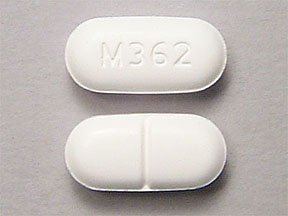
Hydrocodone is prescribed predominantly within the United States, with the International Narcotics Control Board reporting that 99% of the worldwide supply in 2007 was consumed in the United States. Several common imprints for hydrocodone are V4212, M365, M366, M367.
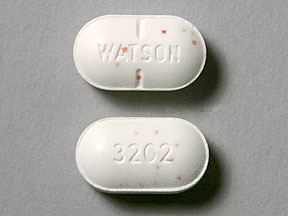
Your brain on drugs hydrocodone college health guru
Medical uses
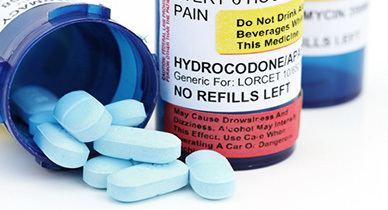
Hydrocodone is used to treat moderate to severe pain and as an antitussive to treat cough. In one study comparing the potency of hydrocodone to that of oxycodone, it was found that it took 50% more hydrocodone to achieve the same degree of miosis (pupillary contraction). The investigators interpreted this to mean that oxycodone is about 50% more potent than hydrocodone.
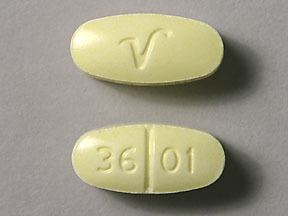
However, in a study of emergency room patients with fractures, it was found that an equal amount of either drug provided about the same degree of pain relief, indicating that there is little practical difference between them when used for that purpose. Some references state that the analgesic action of hydrocodone begins in 20–30 minutes and lasts about 4–8 hours. The manufacturer's information says onset of action is about 10–30 minutes and duration is about 4–6 hours. Recommended dosing interval is 4–6 hours.
Available forms
Hydrocodone is available in a variety of formulations for oral administration:
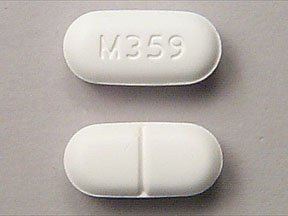
Hydrocodone is not available in parenteral or any other non-oral forms.
Adverse effects
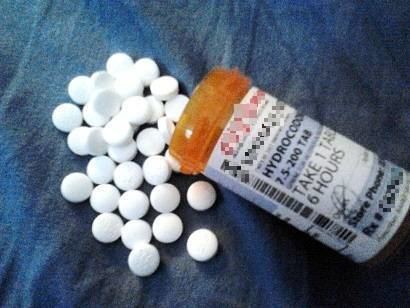
Common side effects of hydrocodone are nausea, vomiting, constipation, drowsiness, dizziness, lightheadedness, anxiety, abnormally happy or sad mood, dry throat, difficulty urinating, rash, itching, and narrowing of the pupils. Serious side effects include slowed or irregular breathing and chest tightness.
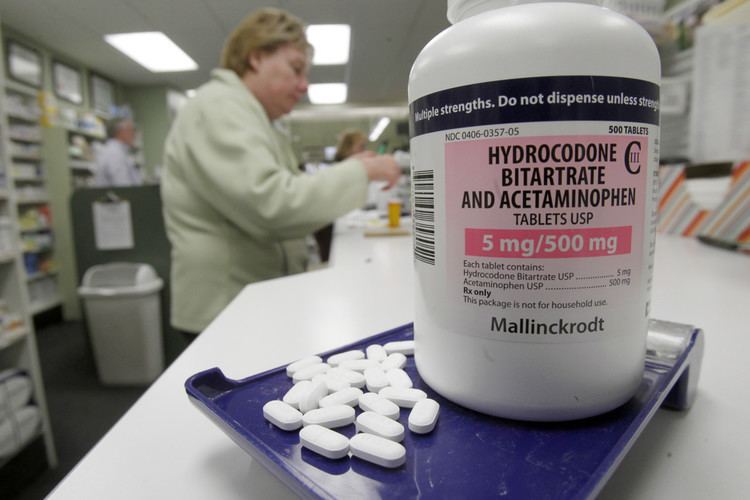
Several cases of progressive bilateral hearing loss unresponsive to steroid therapy have been described as an infrequent adverse reaction to hydrocodone/paracetamol misuse. This adverse effect has been considered by some to be due to the ototoxicity of hydrocodone. Other researchers have suggested that paracetamol is the primary agent responsible for the ototoxicity.
Hydrocodone is in U.S. Food and Drug Administration (FDA) pregnancy category C. No adequate and well-controlled studies in humans have been conducted. A newborn of a mother taking opioid medications regularly prior to the birth will be physically dependent. The baby may also exhibit respiratory depression if the opioid dose was high. An epidemiological study indicated that opioid treatment during early pregnancy results in increased risk of various birth defects.
Symptoms of hydrocodone overdose include narrowed or widened pupils; slow, shallow, or stopped breathing; slowed or stopped heartbeat; cold, clammy, or blue skin; excessive sleepiness; loss of consciousness; seizures; or death.
Hydrocodone can be habit forming, causing physical and psychological dependence. Its abuse liability is similar to morphine and less than oxycodone.
Contraindications and interactions
Patients consuming alcohol, other opioids, antihistamines, anti-psychotics, anti-anxiety agents, or other central nervous system (CNS) depressants together with hydrocodone may exhibit an additive CNS depression. Hydrocodone may interact with serotonergic medications.
Pharmacology
As a narcotic, hydrocodone relieves pain by binding to and activating opioid receptors, namely the μ-opioid receptor (MOR), in the central nervous system. It acts primarily on MORs, with about six times lesser affinity to the δ-opioid receptor (DOR). In blood, 20–50% of hydrocodone is bound to protein.
Studies have shown hydrocodone is stronger than codeine but only one-tenth as potent as morphine at binding to receptors and reported to be only 59% as potent as morphine in analgesic properties. However, in tests conducted on rhesus monkeys, the analgesic potency of hydrocodone was actually higher than morphine. Oral hydrocodone has a mean equivalent daily dosage (MEDD) factor of 0.4, meaning that 1 mg of hydrocodone is equivalent to 0.4 mg of intravenous morphine. However, because of morphine's low oral bioavailability, there is a 1:1 correspondence between orally administered morphine and orally administered hydrocodone. The relative milligram strength of hydrocodone to codeine is given as 6 fold, that is 5 mg has the effect of 30 mg of codeine; by way of the Roman numeral VI this is said to have given rise to the trade name Vicodin.
Pharmacokinetics
Hydrocodone is only pharmaceutically available as an oral drug. The onset of action of hydrocodone via this route is 10 to 20 minutes, with a peak effect (Tmax) occurring at 30 to 60 minutes, and it has a duration of 4 to 8 hours.
Metabolism
In the liver, hydrocodone is transformed into several metabolites, including norhydrocodone, hydromorphone, 6α-hydrocodol (dihydrocodeine), and 6β-hydrocodol. 6α- and 6β-hydromorphol are also formed, and the metabolites of hydrocodone are conjugated (via glucuronidation). Hydrocodone has a terminal half-life that averages 3.8 hours (range 3.3–4.4 hours). The hepatic cytochrome P450 enzyme CYP2D6 converts hydrocodone into hydromorphone, a more potent opioid (5-fold higher binding affinity to the MOR). However, extensive and poor cytochrome 450 CYP2D6 metabolizers had similar physiological and subjective responses to hydrocodone, and CYP2D6 inhibitor quinidine did not change the responses of extensive metabolizers, suggesting that inhibition of CYP2D6 metabolism of hydrocodone has no practical importance. Ultra-rapid CYP2D6 metabolizers (1–2% of the population) may have an increased response to hydrocodone; however, hydrocodone metabolism in this population has not been studied.
Norhydrocodone, the major metabolite of hydrocodone, is predominantly formed by CYP3A4-catalyzed oxidation. In contrast to hydromorphone, it is described as inactive. However, norhydrocodone is actually a MOR agonist with similar potency to hydrocodone, but has been found to produce only minimal analgesia when administered peripherally to animals (likely due to poor blood-brain-barrier and thus central nervous system penetration). Inhibition of CYP3A4 in a child who was, in addition, a poor CYP2D6 metabolizer, resulted in a fatal overdose of hydrocodone. Approximately 40% of hydrocodone metabolism is attributed to non-cytochrome-catalyzed reactions.
Combination products
Most hydrocodone is formulated in combination with a second analgesic, such as paracetamol (acetaminophen) or ibuprofen. Examples of hydrocodone combinations include Norco, Vicodin, Lortab, Vicoprofen and Riboxen.
Zohydro ER
In 2014, the FDA approved prescription-only marketing by Zogenix Pharmaceuticals of the first pure hydrocodone product in the U.S, known by the brand name Zohydro ER. The drug comes in extended-release capsules with hydrocodone powder inside, in doses of 10 mg, 15 mg, 20 mg, 30 mg, 40 mg and 50 mg. This is up to 5 times as much active opioid as the highest strength hydrocodone/APAP product (10 mg/325 mg), but it is important to note that the hydrocodone in Zohydro formulations is intended to be slowly released over 12 hours. Zohydro ER (hydrocodone bitartrate) is indicated for the management of pain severe enough to require daily, around-the-clock, long-term opioid treatment for which alternative treatment options are inadequate. Zohydro is a schedule II controlled substance under the CSA.
The approval of Zohydro ER was controversial, due to concerns over its potential for substance abuse. The FDA approved Zohydro ER over the objections of its own review panel, which voted 12 to 2 against approval. The panel stated that if approved, Zohydro ER would likely "be abused, possibly at a rate greater than that of currently available hydrocodone combination products". Thirty U.S. states asked the FDA not to approve Zohydro ER in capsule form due to its potency and the ease with which it could be abused, by being crushed and then snorted or injected. Zohydro ER was briefly prohibited in Massachusetts before a federal judge ruled that the state's ban was preempted by the earlier federal approval.
Detection in body fluids
Hydrocodone concentrations are measured in blood, plasma, and urine to seek evidence of misuse, to confirm diagnoses of poisoning, and to assist in investigations into deaths. Many commercial opiate screening tests react indiscriminately with hydrocodone, other opiates, and their metabolites, but chromatographic techniques can easily distinguish hydrocodone uniquely. Blood and plasma hydrocodone concentrations typically fall into the 5–30 µg/L range among people taking the drug therapeutically, 100–200 µg/L among recreational users, and 100–1,600 µg/L in cases of acute, fatal overdosage. Co-administration of the drug with food or alcohol can very significantly increase the resulting plasma hydrocodone concentrations that are subsequently achieved.
History
Hydrocodone was first synthesized in Germany in 1920 by Carl Mannich and Helene Löwenheim. It was approved by the Food and Drug Administration on 23 March 1943 for sale in the United States and approved by Health Canada for sale in Canada under the brand name Hycodan.
Hydrocodone was first marketed by Knoll as Dicodid, starting in February 1924 in Germany.This name is analogous to other products the company introduced or otherwise marketed: Dilaudid (hydromorphone, 1926), Dinarkon (oxycodone, 1917), Dihydrin (dihydrocodeine, 1911), and Dimorphan (dihydromorphine). Paramorfan is the trade name of dihydromorphine from another manufacturer, as is Paracodin, for dihydrocodeine.
The name Dicodid was registered in the United States and appears without a monograph as late as 1978 in the Physicians' Desk Reference; Dicodid may have been marketed to one extent or another in North America in the 1920s and early 1930s. The drug was pure hydrocodone in small 5 and 10 mg tablets, physically similar to the Dilaudid tablets. It is no longer manufactured by Knoll in Germany, nor is a generic available. Hydrocodone was never as common in Europe as it is in North America—dihydrocodeine is used for its spectrum of indications. Germany was the number two consumer of hydrocodone until the manufacture of the drug was discontinued there. Now, the world outside the United States accounts for less than 1% of annual consumption. It was listed as a Suchtgift under the German Betäubungsmittelgesetz and regulated like morphine. It became available in the Schengen Area of the European Union as of 1 January 2002 under Title 76 of the Schengen Treaty.
US Schedule
The US government imposed tougher prescribing rules for Hydrocodone in 2014, changing the drug from Schedule III to Schedule II. In 2011, hydrocodone products were involved in around 100,000 abuse-related emergency department visits in the United States, more than double the number in 2004.
